The Making of a Modern Pilgrim
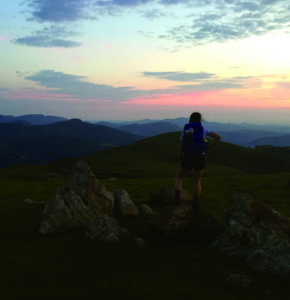
The Camino de Santiago is a pilgrimage like no other, defying conventional wisdom about what constitutes a pilgrim, and about the supposedly unavoidable schism between religion and humanism.
THE CAMINO DE SANTIAGO across the mighty pastoral breadth of northern Spain is no normal pilgrimage. Nonbelievers match if not outnumber the religiously inspired on this epic journey (camino means “journey” in Spanish). But regardless any theological disputes, participants are united by more than what divides them. I heard people continually lament the same problems and trappings of modern society, and of undertaking the Camino to gain thinking space amid the tumult.
“If you live today, you breathe in nihilism, it’s the gas you breathe,” wrote American novelist Flannery O’Connor—and that was in the 1950s.
The Camino is a shared countering of such nihilism for pilgrims, although at the same time the experience proves markedly different for each person.This isn’t surprising given the scope of experiences and emotions that can happen on a route extending for about 900 kilometers east to west if you begin at the most popular starting point just on the other side of the Pyrenees in France’s Saint-Jean-Pied-de-Port, then push on through the city of Santiago de Compostela—technically the end of the pilgrimage—and continue for another eighty-five kilometers or so to the logical terminus at the town of Finisterre on Spain’s Galician coast. Santiago de Compostela is claimed as the resting place of Saint James, for whom the pilgrimage is named.
The experience is also colored by each person’s motivations for doing the Camino—mine were a mixture of the secular, alluded to above, and the more religious: I’m a cradle Catholic. So I was there for both sides of the party. To give you a better idea of how this played out beguilingly beyond any of my expectations, here’s a snapshot of my Camino: golden wheat fields and vineyards stretching to the horizon; the rising sun over my right shoulder and backpack; needing the toilet after overhydrating each morning; recurring tendinitis; cerveza con limón (a deliciously refreshing mixture of beer and lemon); lots of candles in churches; far too much Spanish red wine (especially at lunchtime); hangovers; lust, inspiration, bitterness, and regret during long meditative stretches through the arid Meseta plains; nuns walking across town plazas; Bruce Springsteen lyrics looping through my head; and topics such as abortion, gay marriage, Vatican II, and clerical child abuse debated with young American men considering becoming priests, with lesbian atheists, with those appalled by the church—all of whom shared the deepest yearnings of humanity. Such was the epic scale of sights and sentiments. It often felt overwhelming, and I still feel somewhat shocked by it all, if I’m honest. Shocked in a dazzled, amazingly uplifting way.
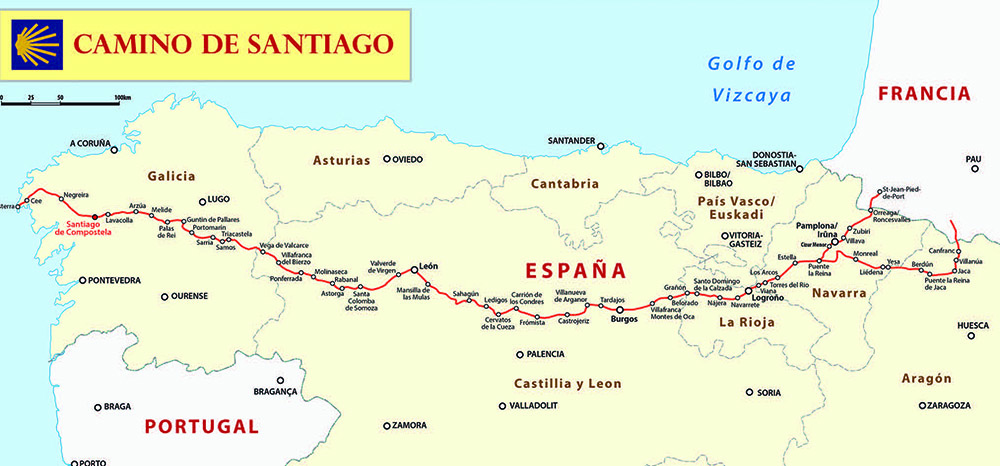
As a result of all this, the Camino more often than not garnishes amazing word of mouth. Which might explain how, despite modern developed societies becoming increasingly secular, this pilgrimage route is growing in popularity (especially among Americans, judging by accents heard and people met along the way).
“I understand that Christian doctrine was how my ancestors made sense of the world, as they had limited notions of science,” says Jessi Whitby, an Australian and avowed atheist doing the Camino. “It was a tool to teach many important and valuable lessons, such as do unto others, love thy neighbor—these are important values that I follow and believe. So even though I don’t believe that God was watching me walk, I liked the idea that I was experiencing a significant part of my cultural history.”
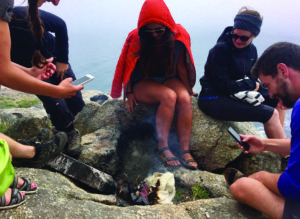
A group of pilgrims burning clothes—a tradition to mark the end of the Camino—amid the rocks at Finisterre. (Photo courtesy Sidse Johannsen)
No matter the country of origin—Italy, Brazil, South Korea, China, the United States, Poland, Australia, and Denmark were notably represented—or what the religious angle or political or sexual orientation, all pilgrims sang the praises of the simplicity, camaraderie, and sense of community engendered by the Camino, and what it teaches you about a potentially better and purer sort of lifestyle. One pilgrim (everyone happily refers to themselves as pilgrims) called the Camino “the Woodstock of our age,” referring to the late 1960s iconic counter-culture music festival: a way of breaking away from the suffocating relentlessness, confusion, and expense of modern society.
“I expected to use the walk as a time to reflect on my life thus far and reset goals for the future,” Whitby says. “However, most of the time I was walking I only thought about where to put my foot next! Or how my body was feeling. It took me awhile to realize that this was the mental break I was looking for—no need to think and puzzle over things or big questions. I was completely present in the moment.”
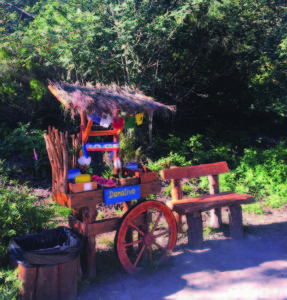
a donativo stall—payment being through donation—found on the Camino route (Photo courtesy Sidse Johannsen)
Another notable feature of the Camino was the number of people undertaking it as a means of processing loss—be it the death of a loved one or the breakup of a long-term relationship. Hence there was much talk about leaving stones representing “your burdens” at various key points—for example people would pile them up beside crucifixes and official way markers. This struck me as a bit corny, to be honest, and I also thought: “Where do I start? I’ll be here all day placing stones.” But by the time I approached Finisterre, the idea’s principle had grown on me, enabling me to process guilt and anger that has stayed with me ever since my Afghanistan tour with the British Army in 2009 (an experience I recounted in “A Redaction of Heroism,” published in the March/April 2014 Humanist).
This restorative and life-enhancing aspect of the Camino process, and the peace of mind and goodwill that results, means there’s scant dissent among pilgrims over potentially contentious issues such as whether nonbelievers are co-opting a sacred tradition.
“As a believing Catholic pilgrim, I sometimes did wish for a more religious atmosphere,” says Joe Szczybor, an American in his early twenties considering a clerical life, adding,
At the same time, I loved talking to people from different backgrounds. There was always the temptation to consider your pilgrimage more “authentic” than others—whether it was for the distance you walked, the weight of your backpack, or, yes, your religious motivation for the walk. In the end, though, I think we were working towards seeing everyone’s Camino as authentic for how they did it.
The Camino’s admixture of religious and secular philosophies is appropriate given its history. The route it follows originally served as a pagan pilgrimage to the coast during the Middle Ages: Finisterre was held as marking the end of the known world; people arrived at the shoreline to gaze in awestruck wonder at the expanse of the Atlantic seemingly stretching into infinity. But around the tenth century the canny Benedictine monks of Cluny in France began fostering its religious reputation based on the claim Saint James preached the gospel in Spain soon after the Crucifixion, and that after his martyrdom in Jerusalem his body was smuggled back to Galicia by a party of Spanish disciples. Unfortunately—or not, depending on your tolerance of religion—all the best scholars seem to agree that Saint James never came to Spain at all. There is no logical reason why his body should be brought to Galicia, and nothing of the sort is suggested in the Acts of the Apostles, where his death is recorded.
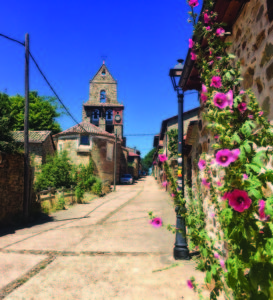
A typically attractive street view in a Spanish village along the way. (Photo courtesy Sidse Johannsen)
So it’s all an illusion. But so long has it been in Spanish minds and in the minds of earnest pilgrims coming during the centuries that it has, in the way of all the best hallucinations with which we trick and comfort ourselves, achieved a kind of truth.
During my Camino, however, another side to that ostensibly religious truth emerged. For the farther I walked, the more a humanist truth began to gain the upper hand. I found myself going into churches to light candles less often; far more prominent in my mind were thoughts about the other pilgrims I had befriended. Where were they? Would our paths cross at the next town where I’d be spending the evening? Would I ever see them again? Increasingly my pilgrimage wasn’t about a destination, self-discovery, or religious affirmation: it was simply about the other pilgrims.
“You realize how much we take people for granted,” Bruno, a Brazilian pilgrim, told me as we surveyed the Atlantic from the lighthouse at Finisterre. “I met so many great people on the Camino and thought I would bump into them again. But I didn’t, and I don’t have their emails or numbers. I may never see them again.”
I sympathized strongly with Bruno. Walking the Camino restored my faith in humanity, by which I mean, speaking as a military veteran, those often suspect individuals: civilians. For ever since I left the army in 2009, I’ve often despaired at the incongruity of how so much of supposedly civilized society exhibits so little of the virtues of self-sacrifice, loyalty, and duty of care that I’d known as axiomatic in the army.
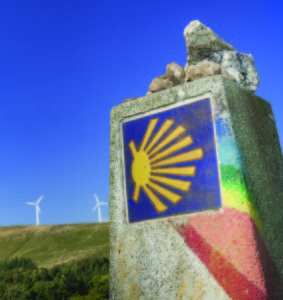
Rocks representing burdens are left behind atop a milestone in Galicia, Spain. (Photo © Maciej Kwiatkowski)
But through the pilgrims—religious and nonreligious—I met on the Camino, I was given an unequivocal demonstration of how wonderfully radical, intelligent, funny, kind, beautiful, and graceful humans can be, as well as how generous and courageous they can be: a German couple in their early thirties with packs on their backs, sweating and pushing two heavy-duty prams containing a baby and two young girls as their dog trotted beside; two Scottish women, one a teacher, the other a care provider for stroke victims, using their precious summer holiday to guide a hulking six-foot-five, visually impaired man up and down the mountainous terrain; pilgrims bedeviled by blisters and swollen tendons, or covered in bug bites from head to toe, fighting through tears to the next hostel.
Exposed to these uplifting examples of human spirit and tenacity, an irrepressible urge to tell all these people how special they were overcame me. I turned into a compulsive hugger, much to my self-conscious embarrassment, as I’ve never been the most tactile individual. (I’m British, after all!) The change in behavior I put down to the Camino ramming home how human life is such a wonderfully radical proposition; how fleeting it most certainly is; and how we are all united by our shared participation in “the whole mad, sad, noble, degraded, endlessly fascinating human story,” to quote the American public intellectual George Weigel.
The Camino also demonstrated how, despite what we may sometimes suspect of our human brothers and sisters, life gains its luster through embracing Thomas Hardy’s madding crowd, not turning away from it. We are communitarian individuals, despite how self-reliant we might like to think ourselves. It’s our engagement with others that gives our existence pluck, verve, and wonder. And I say that as someone who, after his army career, distraught and bemused by what he’d met on the other side, scorned and avoided the madding crowd, choosing to work as a journalist in Ethiopia since 2013.
“As long as you meet other people with respect, atheists, Christians, and Muslims on the Camino get along just fine,” says Sidse Johannsen, a religious studies graduate from Denmark who was on the Camino with me. “And due to the fact that many people are on the Camino for existential questions, the combination of different world and religious views makes your thoughts and questions rise and live.”
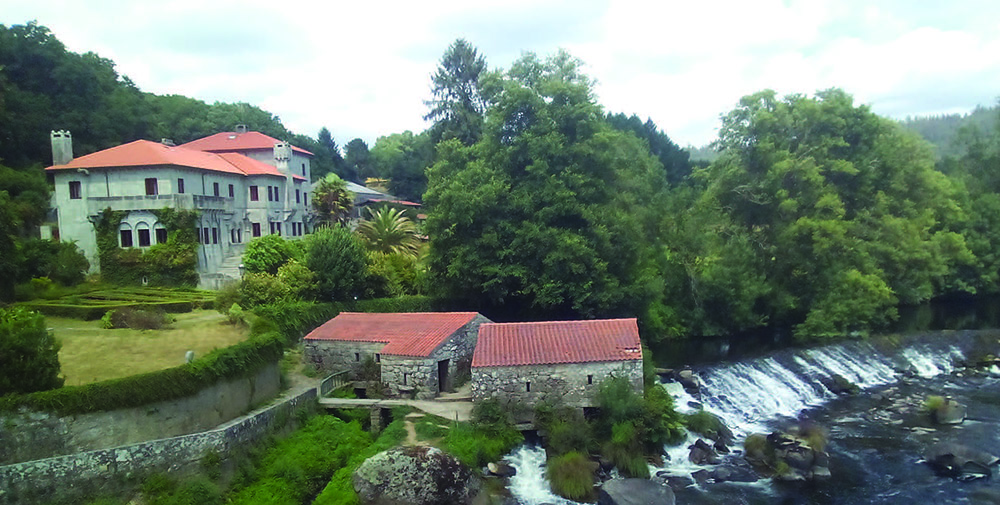
One of many river crossings along the Camino. (Photo by James Jeffrey)
A primal need resides in us all to bear witness and talk to our fellow travelers on this pilgrimage of life that, though we may disagree on much of it, such as origin and destination, should serve as a means of rejoicing in our shared humanity with its wonderful and stirring muddle of contradictions and finer aspirations. The more I hiked on, the deeper this sank in—with a palpable result. My energy levels rocketed. Bitterness and regret evaporated. Two decades were knocked off leaving me feeling and acting like the enthused and goofy eighteen-year-old I once was before the hits and thwarted ambitions of life took their toll. The Camino was a slap-in-the-face reminder that being human and being around other humans can be such enormous fun.
“You can live once more—look at things as you used to look at them,” wrote the pagan Roman emperor Marcus Aurelius in the second century. “In this is the resumption of life.”
